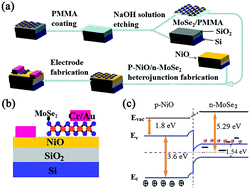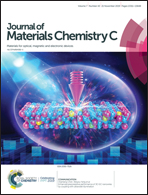Monolayer MoSe2/NiO van der Waals heterostructures for infrared light-emitting diodes†
Abstract
Nowadays monolayer transition metal chalcogenides (TMCs) have been widely researched due to their excellent optoelectronic properties. However, the preparation of large-sized monolayer TMCs and high-power TMC-based light-emitting diodes are still full of challenges, which limit their application in two-dimensional devices. Here, the large-sized monolayer single-crystalline MoSe2 was synthesized by chemical vapor deposition. The influence of the relative gas pressure ratio of MoO3 to Se on MoSe2 morphology is discussed. The TEM analysis confirmed the presence of 2H-phase monolayer MoSe2. A photoluminescence peak from the MoSe2 monolayer is detected at about 804 nm, illustrating an intrinsic energy bandgap of 1.54 eV. Importantly, a novel 2D/3D heterostructure, monolayer MoSe2/NiO van der Waals heterostructure, is constructed for a light-emitting diode (LED). The electroluminescence peaks of n-MoSe2/p-NiO LED locate at 812 nm, 848 nm and 918 nm, all of which are in the infrared light range. Interestingly, the electroluminescence peaks of our n-MoSe2/p-NiO LED are close to those of conventional air conditioner telecontrollers. So the n-MoSe2/p-NiO infrared LED is forward to be used in infrared remote sensing systems in the future.



 Please wait while we load your content...
Please wait while we load your content...